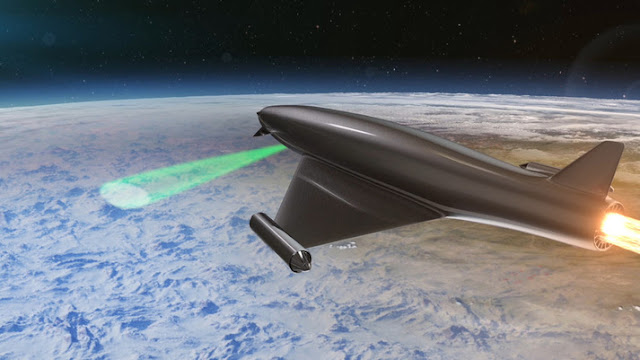BAE wants to enhance the reflective properties of the atmosphere which make desert mirages to create massive lens or shields
by noreply@blogger.com (brian wang) from NextBigFuture.com on (#29E5P)
Atmospheric lens could revolutionize the future of battlefield observation. BAE Systems has been working on a way to use lasers to actively reshape the atmosphere to turn it into a variety of optical tools. The Laser Developed Atmospheric Lens system (LDAL) uses powerful laser pulses to make air itself into lenses, mirrors, and even protective deflector shields.
Within the next fifty years, scientists at BAE Systems believe that battlefield commanders could deploy a new type of directed energy laser and lens system, called a Laser Developed Atmospheric Lens which is capable of enhancing commanders' ability to observe adversaries' activities over much greater distances than existing sensors.
At the same time, the lens could be used as a form of 'deflector shield' to protect friendly aircraft, ships, land vehicles and troops from incoming attacks by high power laser weapons that could also become a reality in the same time period.
The Laser Developed Atmospheric Lens (LDAL) concept, developed by technologists at the Company's military aircraft facility in Warton, Lancashire, has been evaluated by the Science and Technology Facilities Council (STFC) Rutherford Appleton Laboratory and specialist optical sensors company LumOptica and is based on known science. It works by simulating naturally occurring phenomena and temporarily - and reversibly - changes the Earth's atmosphere into lens-like structures to magnify or change the path of electromagnetic waves such as light and radio signals.
LDAL is a complex and innovative concept that copies two existing effects in nature; the reflective properties of the ionosphere and desert mirages. The ionosphere occurs at a very high altitude and is a naturally occurring layer of the Earth's atmosphere which can be reflective to radio waves - for example it results in listeners being able to tune in to radio stations that are many thousands of miles away. The radio signals bounce off the ionosphere allowing them to travel very long distances through the air and over the Earth's surface. The desert mirage provides the illusion of a distant lake in the hot desert. This is because the light from the blue sky is 'bent' or refracted by the hot air near the surface and into the vision of the person looking into the distance.

Read more










Within the next fifty years, scientists at BAE Systems believe that battlefield commanders could deploy a new type of directed energy laser and lens system, called a Laser Developed Atmospheric Lens which is capable of enhancing commanders' ability to observe adversaries' activities over much greater distances than existing sensors.
At the same time, the lens could be used as a form of 'deflector shield' to protect friendly aircraft, ships, land vehicles and troops from incoming attacks by high power laser weapons that could also become a reality in the same time period.
The Laser Developed Atmospheric Lens (LDAL) concept, developed by technologists at the Company's military aircraft facility in Warton, Lancashire, has been evaluated by the Science and Technology Facilities Council (STFC) Rutherford Appleton Laboratory and specialist optical sensors company LumOptica and is based on known science. It works by simulating naturally occurring phenomena and temporarily - and reversibly - changes the Earth's atmosphere into lens-like structures to magnify or change the path of electromagnetic waves such as light and radio signals.
LDAL is a complex and innovative concept that copies two existing effects in nature; the reflective properties of the ionosphere and desert mirages. The ionosphere occurs at a very high altitude and is a naturally occurring layer of the Earth's atmosphere which can be reflective to radio waves - for example it results in listeners being able to tune in to radio stations that are many thousands of miles away. The radio signals bounce off the ionosphere allowing them to travel very long distances through the air and over the Earth's surface. The desert mirage provides the illusion of a distant lake in the hot desert. This is because the light from the blue sky is 'bent' or refracted by the hot air near the surface and into the vision of the person looking into the distance.

Read more